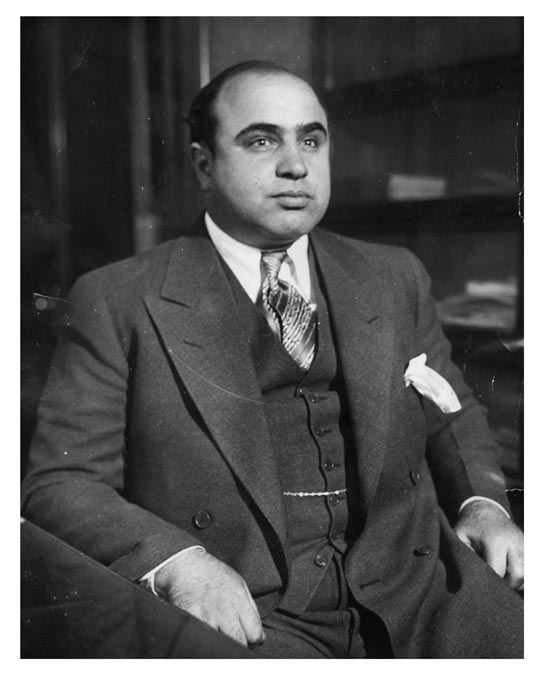

His father, Gabriele, was a barber from Italy and sired nine children. Alphonse Gabriel Capone was born January 17, 1899 and died January 25, 1947 at age 48 and is buried at Mount Carmel Cemetery in Hillside, Ill..
Capone showed promise as a student, but had trouble with the rules at the strict parochial Catholic school in Brooklyn, N.Y.. His Official school instruction ended at the age of 14 after he was expelled for hitting a female teacher in the face. He worked at a candy store, a bowling alley, and played semi-professional baseball for two years.
He was married to Mae Josephine Coughlin at age 19 December 30, 1918. Earlier that month she gave birth to their son, Albert Francis Capone. It seemed that they had a happy marriage despite his criminal lifestyle.
He was an American gangster who ran the Chicago Outfit. Capone had expanded the bootlegging business with increasingly violent means and made more than $100 million a year. That money was realized by alcohol, women/brothels, and jazz speakeasies.
He cultivated relationships with mayor William Hale Thompson and Chicago’s police which meant he seemed safe from law enforcement. Time magazine named him Man of the Year until newspapers called him “Public Enemy No. 1” after February 14, 1929.
On that day seven rival gang members were murdered in broad daylight in a Chicago warehouse. Then, federal authorities began to document 22 counts of tax evasion. He was convicted of five counts in 1931. He was sentenced to 11 years in federal prison. He already was showing signs of neurosyphilis.
Al Capone liked to dress with impeccable taste and wore the classic fedora hat. His suits and ties were purchased at fine men’s stores, custom made, in Chicago. As the man who controlled the criminal underworld in Chicago, he wanted to look successful. He was called “Snorky” by his closest friends, a term for a sharp dresser. He was particularly known for his flamboyant and costly jewelry. He would say “I am just a businessman, giving the people what they want.” Or “All I do is satisfy a public demand.”
He had nicknames such as Scarface, Big Al, and Big Boy. Any establishment that refused to purchase liquor from him often got blown up and as many as 100 persons were killed in such bombings during the 1920s.He used increased violence to have more revenue. He smoked cigars, liked gourmet food and drink, and female companionship. He seemingly was a man without morals or self-discipline.
Wherever I am visiting and I say I am from the Chicago area, invariably the other person will smile and say “Oh, Al Capo ne.” And then they make motions such as a Tommy gun going off, saying gangster. If part of his drive was to be rich, was part of it recognition, too? From the Italian slums of New York, to the dark alleys of Chicago, did he feel any satisfaction with his wanton way of life?
Capone liked jazz and often enlisted the help of local members of the black community to play for him on the South Side of Chicago. Capone once sent two bodyguards to accompany jazz pianist, Earl Hines, on a road trip.
He kept a mansion on Palm Island, Fla., estate he purchased the in 1928 as a Winter retreat and lived there until his death in 1947.

